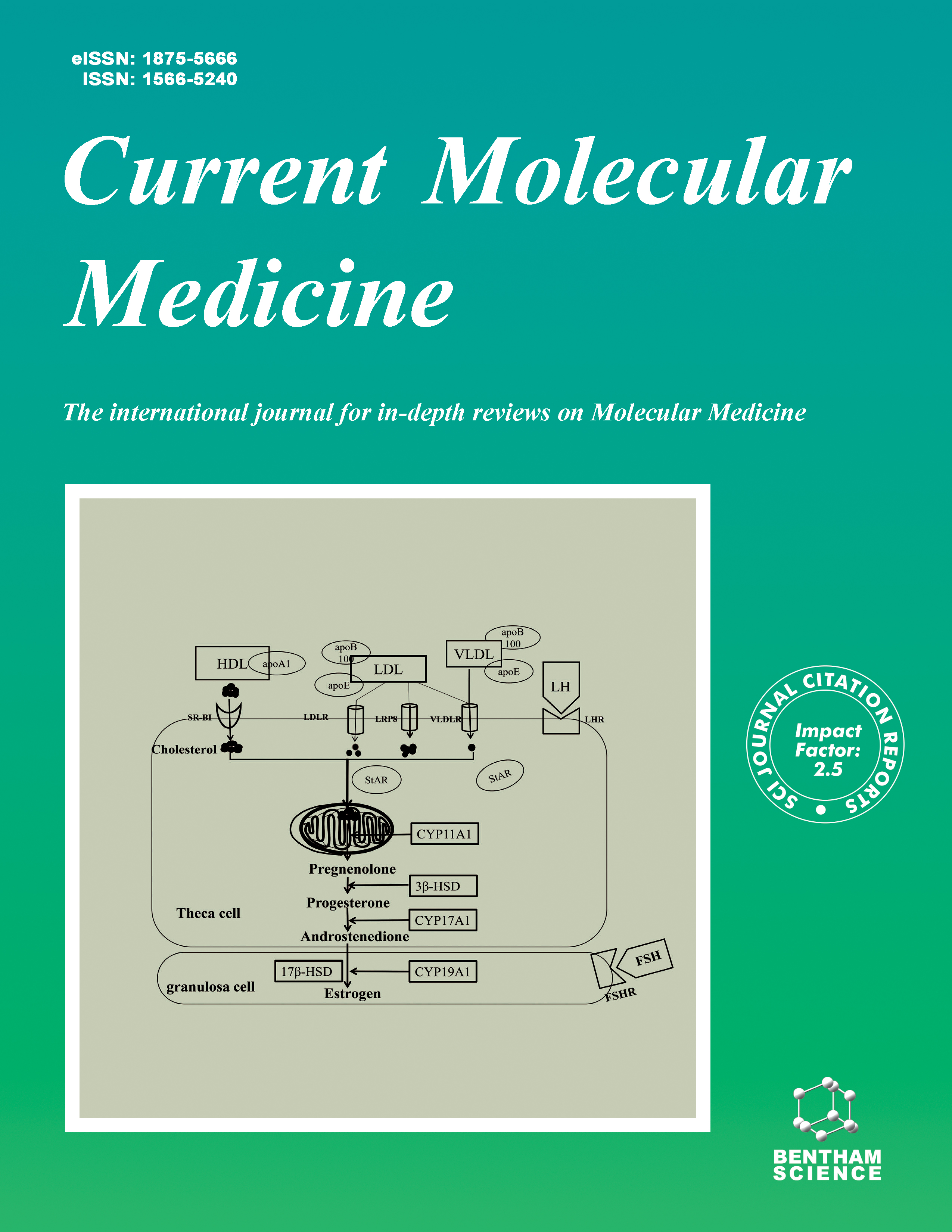- Home
- A-Z Publications
- Current Molecular Medicine
- Previous Issues
- Volume 25, Issue 1, 2025
Current Molecular Medicine - Volume 25, Issue 1, 2025
Volume 25, Issue 1, 2025
-
-
Dysregulated Long Non-coding RNAs in Myasthenia Gravis-A Mini-Review
More LessAuthors: Liying Sun, Xuhui Ye, Linlin Wang, Junping Yu, Yan Wu, Yun Hua and Lihua DaiMyasthenia gravis (MG) is an acquired autoimmune disease that is mediated by humoral immunity, supplemented by cellular immunity, along with participation of the complement system. The pathogenesis of MG is complex; although autoimmune dysfunction is clearly implicated, the specific mechanism remains unclear. Long non-coding RNAs (lncRNAs) are a class of non-coding RNA molecules with lengths greater than 200 n Read More
-
-
-
A New Strategy for Obesity Treatment: Revealing the Frontiers of Anti-obesity Medications
More LessAuthors: Pan-feng Huang, Qi-Yu Wang, Rong-Bin Chen, Ya-Di Wang, Yuan-Yuan Wang, Jiang-Hua Liu, Xin-Hua Xiao and Zhe-Zhen LiaoObesity dramatically increases the risk of type 2 diabetes, fatty liver, hypertension, cardiovascular disease, and cancer, causing both declines in quality of life and life expectancy, which is a serious worldwide epidemic. At present, more and more patients with obesity are choosing drug therapy. However, given the high failure rate, high cost, and long design and testing process for discovering and developing new anti-ob Read More
-
-
-
Hypoxia Affects Mitochondrial Stress and Facilitates Tumor Metastasis of Colorectal Cancer Through Slug SUMOylation
More LessAuthors: Jin-bao Wang, Shi-lin Ding, Xiao-song Liu, Tianren Yu, Zeng-an Wu and Yu-xiang LiBackgroundColorectal cancer (CRC) is a malignant tumor. Slug has been found to display a key role in diversified cancers, but its relevant regulatory mechanisms in CRC development are not fully explored.ObjectiveHence, exploring the function and regulatory mechanisms of Slug is critical for the treatment of CRC.MethodsProtein expressions of Slug, N-cadherin, E-cadherin, Snail, HIF-1α, SUMO-1, Drp1, Opa1, Mfn1/2 Read More
-
-
-
A Mechanism Study on the Antioxidant Pathway of Keap1-Nrf2-ARE Inhibiting Ferroptosis in Dopaminergic Neurons
More LessAuthors: Yani-Yao, Pei-shan Li, Sen-Jiang, XinLing-Meng, Hua-Gao and XinLing-YangBackgroundThe pathology of Parkinson's disease (PD) indicates that iron deposition exists in dopaminergic neurons, which may be related to the death of cellular lipid iron peroxide. The extracellular autophagy adaptor SQSTM1(p62) of dopamine (DA) neurons can activate the intracellular Keap1-Nrf2-ARE signaling pathway to inhibit ferroptosis, which has a protective effect on DA neurons.ObjectiveThe objective of this stud Read More
-
-
-
ADGRL4 Promotes Cell Growth, Aggressiveness, EMT, and Angiogenesis in Neuroblastoma via Activation of ERK/STAT3 Pathway
More LessAuthors: Geng Geng, Lei Zhang, Ying Yu, Xingqing Guo, Qinghao Li and Ming MingBackgroundNeuroblastoma (NB) is one of the most common pediatric solid tumors. Emerging evidence has indicated that ADGRL4 can act as a master regulator of tumor progression. In addition, it is well documented that the ERK/STAT3 signaling pathway can promote the proliferation, EMT, angiogenesis, and metastasis in tumors. The current study was formulated to elucidate the exact role of ADGRL4 in the malignant behav Read More
-
-
-
Histone Deacetylase 2 Stabilizes SPARC-related Modular Calcium Binding 2 to Promote Metastasis and Stemness in Gallbladder Cancer
More LessAuthors: Ji Feng and Xueyong ZhengBackgroundWe aimed to investigate the relationship between histone deacetylase 2 (HDAC2) and SPARC-related modular calcium binding 2 (SMOC2) and the role of SMOC2 in gallbladder cancer (GBC).MethodsThe expression of HDAC2 and SMOC2 in GBC and normal cells was detected by quantitative real-time reverse transcription polymerase chain reaction (qRT-PCR), which was also used to detect the mRNA stability of Read More
-
-
-
Amiodarone Advances the Apoptosis of Cardiomyocytes by Repressing Sigmar1 Expression and Blocking KCNH2-related Potassium Channels
More LessAuthors: Huiqing Liang, Huixian Li, Fangjiang Li, Xiaobo Xiong and Yang GaoBackgroundHeart failure (HF) is the ultimate transformation result of various cardiovascular diseases. Mitochondria-mediated cardiomyocyte apoptosis has been uncovered to be associated with this disorder.ObjectiveThis study mainly delves into the mechanism of the anti-arrhythmic drug amiodarone on mitochondrial toxicity of cardiomyocytes.MethodsThe viability of H9c2 cells treated with amiodarone at 0.5, 1, 2, 3, and Read More
-
-
-
IL-1β-Stimulated Bone Mesenchymal Stem Cell-Derived Exosomes Mitigate Sepsis through Modulation of HMGB1/AKT Pathway and M2 Macrophage Polarization
More LessAuthors: Yang Li, Zifa Sun, Yuanyuan Li, Jing Sun and Biquan ChenBackgroundSepsis is a life-threatening disease caused by infection, and developing novel strategies against sepsis is still required. Exosomes derived from mesenchymal stem cells (MSCs) have shown promising therapeutic potential for various diseases. In this study, we aimed to investigate the action and mechanism of exosomes derived from IL-1β-pre-conditioned bone marrow-derived mesenchymal stromal cell Read More
-
-
-
Neferine Targeted the NLRC5/NLRP3 Pathway to Inhibit M1-type Polarization and Pyroptosis of Macrophages to Improve Hyperuricemic Nephropathy
More LessAuthors: Wei Yin, Jin-Hua Wang, Yu-Mei Liang, Kang-Han Liu, Ying Chen and Yusa ChenBackgroundNeferine (Nef) has a renal protective effect. This research intended to explore the impact of Nef on hyperuricemic nephropathy (HN).MethodsAdenine and potassium oxonate were administered to SD rats to induce the HN model. Bone marrow macrophages (BMDM) and NRK-52E were used to construct a transwell co-culture system. The polarization of BMDM and apoptosis levels were detected using immunofl Read More
-
Volumes & issues
-
Volume 25 (2025)
-
Volume 24 (2024)
-
Volume 23 (2023)
-
Volume 22 (2022)
-
Volume 21 (2021)
-
Volume 20 (2020)
-
Volume 19 (2019)
-
Volume 18 (2018)
-
Volume 17 (2017)
-
Volume 16 (2016)
-
Volume 15 (2015)
-
Volume 14 (2014)
-
Volume 13 (2013)
-
Volume 12 (2012)
-
Volume 11 (2011)
-
Volume 10 (2010)
-
Volume 9 (2009)
-
Volume 8 (2008)
-
Volume 7 (2007)
-
Volume 6 (2006)
-
Volume 5 (2005)
-
Volume 4 (2004)
-
Volume 3 (2003)
-
Volume 2 (2002)
-
Volume 1 (2001)
Most Read This Month
Article
content/journals/cmm
Journal
10
5
false
en


